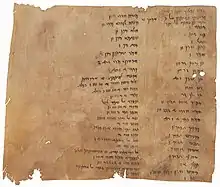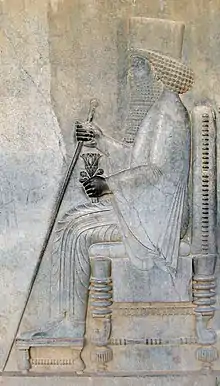Bessus
Bessus, also known by his throne name Artaxerxes V (died summer 329 BC), was a prominent Persian satrap of Bactria in Persia,[1] and later self-proclaimed king of Persia. According to classical sources, he killed his predecessor and relative,[1][2] Darius III, after the Persian army had been defeated by Alexander the Great.
| Artaxerxes V Bessus | |
|---|---|
| King of Kings of the Achaemenid Empire | |
| Reign | 330–329 BC |
| Predecessor | Darius III |
| Successor | Alexander the Great (Macedonian Empire) |
| Died | 329 BC Ecbatana |
| House | Achaemenid Dynasty |
| Religion | Zoroastrianism |
Background
At the Battle of Gaugamela (1 October 331 BC), in which Alexander defeated Darius III, Bessus commanded the left wing of the Persian army, chiefly composed of warriors from his Satrapy who had been mobilized before the Battle of Issus. The envelopment ordered by Darius failed and the Persians lost the battle after hours of fierce fighting. Bessus survived the battle and remained with his king, whose routed army eluded Alexander's forces and spent the winter in Ecbatana. The next year Darius attempted to flee to Bactria in the east. Bessus, conspiring with fellow satraps, deposed Darius and, according to sources, put him in golden chains. It is not clear whether Bessus was motivated primarily by personal ambition or by disillusionment with Darius as a leader. He may have intended to surrender the deposed king to the Macedonians, but Alexander ordered his forces to continue to pursue the Persians.
According to sources, the panicked conspirators stabbed Darius and left him dying in a cart to be found by a Macedonian soldier. The Babylonian Chronicle known as BCHP 1 indicates this happened in July 330 BC. The site has been identified near modern Ahuan.

Bessus immediately proclaimed himself king of kings of Persia and adopted the throne name Artaxerxes (V). His self-proclaimed ascension was justifiable, since the satrap of Bactria, known as mathišta, was the Persian noble next in the line of succession to the Persian throne. But since most of the Achaemenid Empire had already been conquered and Bessus only ruled over a loose alliance of those provinces not yet occupied by the Macedonians, historians do not generally regard him as a king.
Capture and execution
Bessus returned to Bactria and tried to organize resistance among the eastern satrapies. Alexander was forced to move his force to suppress the uprising in 329 BC, entering Bactria. After burning the crops Bessus fled east, crossing the river Oxus. However his own Bactrian mounted levies deserted en masse, rather than abandon their homeland. Bessus was seized by several of his chieftains who handed him over to the pursuing Macedonians in an isolated village. The Macedonian vanguard was commanded by General Ptolemy who, under orders from Alexander, had the former satrap put in a wooden collar and tied naked to a stake by the road down which the main army was marching.[3] Alexander questioned Bessus as to why he had betrayed Darius and continued to lead resistance to the Macedonians. Bessus claimed that he had been only one of several nobles who had jointly agreed on the need to dethrone their irresolute king. Unsatisfied by his responses Alexander ordered the prisoner to be whipped and taken to Balkh and then to Hamadan for trial and punishment.
A fellow conspirator against Darius, Satibarzanes Satrap of Aria, had already surrendered to Alexander and had been pardoned.[4] However, unlike Bessus, Satibarzanes had not aspired to the Persian throne. At Hamadan, Alexander ordered that Bessus's nose and earlobes be cut off, which was a Persian custom for those involved in rebellion and regicide; the Behistun inscription relates that Darius the Great punished the usurper Phraortes of Media (who was the son of Upadaranma, king of Media) in a similar manner (c. 521 BC).
Ancient reports contradict each other about the nature of Bessus's execution. The historian Quintus Curtius Rufus says he was crucified in the place where Darius had been killed, Arrian states that he was tortured and then decapitated in Ecbatana, and Plutarch suggests that he was torn apart in Bactria by recoiling trees after a Macedonian trial, a style which was according to Persian custom: two trees would have been forcibly bent towards each other, the victim tied to both, and then the trees released, causing an agonizing and drawn-out death in which the ligaments, tendons, muscles and organs would slowly come apart as the trees straightened themselves.[5]
References
- Heckel, Waldemar (2008). Who's Who in the Age of Alexander the Great. pp. 67–73. doi:10.1002/9780470757604.ch2.
- Gershevitch, Ilya; Fisher, William Bayne; Boyle, J. A. (1985). The Cambridge History of Iran, Volume 2. Cambridge University Press. p. 449. ISBN 978-0-521-20091-2.
- Robin Lane Fox, page 300 "Alexander the Great", Library of Congress CCN 73-18880
- Robin Lane Fox, page 280 "Alexander the Great", Library of Congress CCN 73-18880
- Michael Scott (16 September 2010). From Democrats to Kings: The Brutal Dawn of a New World from the Downfall of Athens to the Rise of Alexan. Overlook. p. 146. ISBN 978-1-4683-0280-6.
External links
| Wikisource has the text of the 1911 Encyclopædia Britannica article Bessus. |
Bessus Born: ? Died: 329 BC | ||
| Regnal titles | ||
|---|---|---|
| Preceded by Darius III |
King of Kings of Persia 330–329 BC |
Succeeded by Alexander III (Alexander the Great) |
